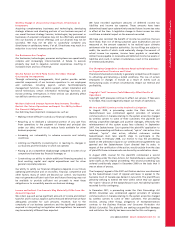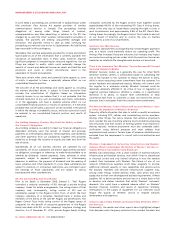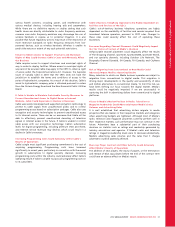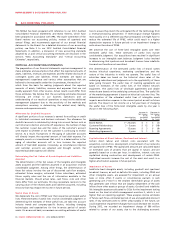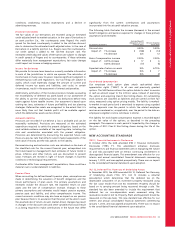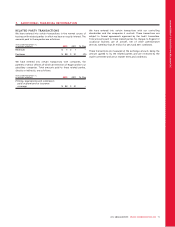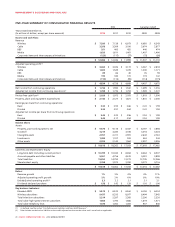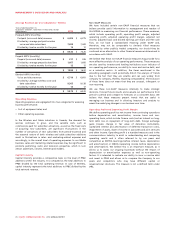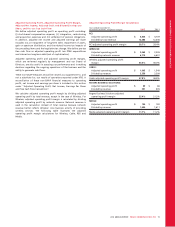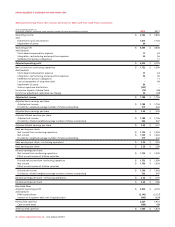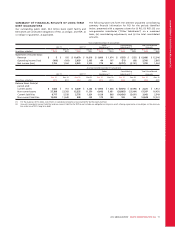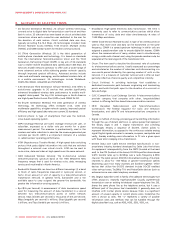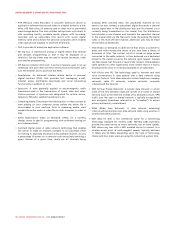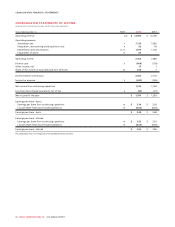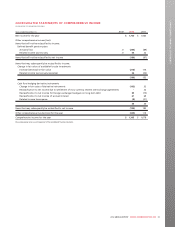Rogers 2012 Annual Report Download - page 77
Download and view the complete annual report
Please find page 77 of the 2012 Rogers annual report below. You can navigate through the pages in the report by either clicking on the pages listed below, or by using the keyword search tool below to find specific information within the annual report.
MANAGEMENT’S DISCUSSION AND ANALYSIS
CONTROLS AND PROCEDURES
Disclosure Controls and Procedures
As of the end of the period covered by this report (the “Evaluation
Date”), we conducted an evaluation (under the supervision and with
the participation of our management, including the Chief Executive
Officer and Chief Financial Officer), pursuant to Rule 13a-15
promulgated under the Securities Exchange Act of 1934, as amended,
of the effectiveness of the design and operation of our disclosure
controls and procedures. Based on this evaluation, our Chief Executive
Officer and Chief Financial Officer concluded that, as of the
Evaluation Date, such disclosure controls and procedures were
effective.
Management’s Report on Internal Control over Financial
Reporting
The management of Rogers is responsible for establishing and
maintaining adequate internal controls over financial reporting. Our
internal control system was designed to provide reasonable assurance
to our management and Board of Directors regarding the preparation
and fair presentation of published financial statements in accordance
with generally accepted accounting principles. All internal control
systems, no matter how well designed, have inherent limitations.
Therefore, even those systems determined to be effective can provide
only reasonable assurance with respect to financial statement
preparation and presentation.
Our management maintains a comprehensive system of controls
intended to ensure that transactions are executed in accordance with
management’s authorization, assets are safeguarded, and financial
records are reliable. Management also takes steps to see that
information and communication flows are effective and to monitor
performance, including performance of internal control procedures.
Management assessed the effectiveness of our internal control over
financial reporting as of December 31, 2012, based on the criteria set
forth in the Internal Control-Integrated Framework issued by the
Committee of Sponsoring Organizations of the Treadway Commission
(“COSO”). Based on this assessment, management has concluded that,
as of December 31, 2012, our internal control over financial reporting
is effective. Our independent auditor, KPMG LLP, has issued an audit
report stating that we maintained, in all material respects, effective
internal control over financial reporting as of December 31, 2012,
based on the criteria established in Internal Control-Integrated
Framework issued by the COSO.
Changes in Internal Control over Financial Reporting and
Disclosure Controls and Procedures
There have been no changes in our internal controls over financial
reporting during 2012 that have materially affected, or are
reasonably likely to materially affect, our internal controls over
financial reporting.
KEY PERFORMANCE INDICATORS AND NON-GAAP
MEASURES
Key Performance Indicators
We measure the success of our strategies using a number of key
performance indicators, which are outlined below. The following key
performance indicators are not measurements in accordance with IFRS
and should not be considered as an alternative to net income or any
other measure of performance under IFRS.
Subscriber Counts
We determine the number of subscribers to our services based on
active subscribers. A wireless subscriber is represented by each
identifiable telephone number. Cable Television and Internet
subscribers are represented by a dwelling unit, and cable telephony
subscribers are represented by line counts. In the case of multiple
units in one dwelling, such as an apartment building, each tenant
with cable service, whether invoiced individually or having services
included in his or her rent, is counted as an individual subscriber.
Institutional units, such as hospitals or hotels, are each considered to
be one subscriber. When subscribers are deactivated, either
voluntarily or involuntarily for non-payment, they are considered to
be deactivations in the period the services are discontinued. Wireless
prepaid subscribers are considered active for a period of 180 days
from the date of their last revenue-generating usage.
We report wireless subscribers in two categories: postpaid and
prepaid. Postpaid and prepaid include voice-only subscribers, data-
only subscribers, and subscribers with service plans integrating both
voice and data.
Internet, Home Phone and RBS subscribers include only those
subscribers with service installed, operating and on billing and
excludes those subscribers who have subscribed to the service but for
whom installation of the service was still pending.
Subscriber Churn
Subscriber churn is calculated on a monthly basis. For any particular
month, subscriber churn for Wireless and Cable represents the
number of subscribers deactivating in the month divided by the
aggregate number of subscribers at the beginning of the month.
When used or reported for a period greater than one month,
subscriber churn represents the sum of the number of subscribers
deactivating for each period incurred divided by the sum of the
aggregate number of subscribers at the beginning of each period
incurred.
Average Revenue per User
Average Revenue per User (“ARPU”) is calculated on a monthly basis.
For any particular month, ARPU represents monthly revenue divided
by the average number of subscribers during the month. In the case
of Wireless, ARPU represents monthly network revenue divided by the
average number of subscribers during the month. When used in
connection with a particular type of subscriber, ARPU represents
monthly revenue generated from those subscribers divided by the
average number of those subscribers during the month. When used or
reported for a period greater than one month, ARPU represents the
monthly average of the ARPU calculations for the period. We believe
ARPU helps to identify trends and to indicate whether we have been
successful in attracting and retaining higher value subscribers.
2012 ANNUAL REPORT ROGERS COMMUNICATIONS INC. 73




